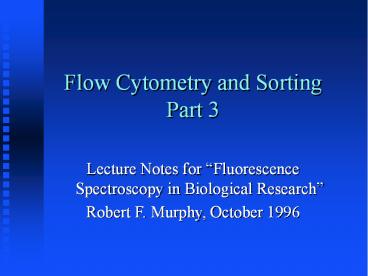Flow Cytometry and Sorting Part 3 - PowerPoint PPT Presentation
Title:
Flow Cytometry and Sorting Part 3
Description:
Flow Cytometry and Sorting Part 3 Lecture Notes for Fluorescence Spectroscopy in Biological Research ... – PowerPoint PPT presentation
Number of Views:216
Avg rating:3.0/5.0
Title: Flow Cytometry and Sorting Part 3
1
Flow Cytometry and Sorting Part 3
- Lecture Notes for Fluorescence Spectroscopy in
Biological Research - Robert F. Murphy, October 1996
2
Basics of Flow Sorting
- Droplet formation
- Timing
- Coincidence - Purity and Efficiency
3
Fluorescence Activated Cell Sorting
FALS Sensor
488 nm laser
Fluorescence detector
-
Charged Plates
Single cells sorted into test tubes
Purdue University Cytometry Laboratories
4
Droplet formation
As liquid is ejected into air, it will form
droplets. By vibrating the nozzle at a defined
frequency, the size of these droplets and the
position along the stream where they form can be
controlled with great precision.
T. Lindmo, D.C. Peters R.G Sweet - MLM Chapt. 8
5
Timing
T. Lindmo, D.C. Peters R.G Sweet - MLM Chapt. 8
6
Coincidence - Purity
- As droplets form, they can contain wanted cells
as well as unwanted cells. If all droplets
containing a wanted cell are sorted (regardless
of whether they also contain unwanted cells), the
purity of the sorted sample will be reduced.
7
Coincidence - Purity
- The purity can be improved by checking for
coincidence events and not sorting any wanted
cell that occurs too close to an unwanted cell. - This causes an increase in purity but a reduction
in sorting efficiency.
8
Coincidence - Efficiency
The efficiency of sorting (with coincidence
checking) for three-droplet sorting (solid lines)
and one-droplet sorting (broken line) is shown as
a function of event rate.
T. Lindmo, D.C. Peters R.G Sweet - MLM Chapt. 8
9
Cell Cycle Analysis
- One of the earliest applications of flow
cytometry was the analysis of cell cycle position
by quantitation of cellular DNA. - Flow cytometry is still the method of choice for
fast, accurate determination of cell cycle
distributions.
10
Univariate Cell Cycle Methods
- In the simplest method, cellular DNA is detected
using a fluorescent dye that binds preferentially
to DNA. - Propidium iodide is most commonly used. It
undergoes a dramatic increase in fluorescence
upon binding DNA. It requires permeabilization
of the plasma membrane. - Hoechst 33342 can be used where labeling of
unpermeabilized (live) cells is desired.
11
Univariate Cell Cycle Methods
- When the amount of DNA per cell is measured on a
sample from an asynchronously growing cell
culture, cells with various amounts of DNA from
the 2N (G0/G1) amount to the 4N (G2/M) amount are
observed. A histogram reveals the fraction of
cells in the various cell cycle phases.
12
Normal Cell Cycle
M
G0
G2
DNA Analysis
G1
s
Count
s
0
200
400
600
800
1000
DNA content
Purdue University Cytometry Laboratories
13
DNA Analysis
0
200
400
600
800
1000
4N
2N
PI Fluorescence
Purdue University Cytometry Laboratories
14
Cell cycle progression of synchronized cells
J.W. Gray, F. Dolbeare M.G. Pallavicini - MLM
Chapt. 23
15
DNA Analysis
Aneuploid peak
0
200
400
600
800
1000
PI Fluorescence
Purdue University Cytometry Laboratories
16
Bivariate Cell Cycle Analysis
- To aid in the detection of cells in S-phase, a
brief pulse of a marked nucleotide can be used.
The most common such nucleotide is
bromodeoxyuridine (BrdU) which is incorporated
into DNA in place of thymidine. The incorporated
BrdU can be detected with an antibody,
identifying those cells that synthesized DNA
during the pulse.
17
Detection of incorporated BrdU
J.W. Gray, F. Dolbeare M.G. Pallavicini - MLM
Chapt. 23
18
J.W. Gray, F. Dolbeare M.G. Pallavicini - MLM
Chapt. 23
19
Chromosome Analysis and Sorting
- Individual chromosomes can be analyzed in flow
after appropriate preservation and isolation.
The most common method is to use two different
DNA dyes, one (Hoechst 33258) that binds
preferentially to AT-rich DNA and one
(chromomycin A3) that binds preferentially to
GC-rich DNA.
20
Two-color chromosome analysis
J.W. Gray L.S. Cram - MLM Chapt. 25
21
Normal human
Normal hamster
Human X hamster
Normal mouse
J.W. Gray L.S. Cram - MLM Chapt. 25
22
Immunofluorescence Analysis
- A major application of flow cytometry is the
analysis (and sorting) of subsets of blood cells
using surface markers. - A useful feature is that the major blood cell
types show distinct forward and side scatter
profiles.
23
Light Scatter Gating
Side Scatter Projection
Neutrophils
Scale
1000
200
100
50
40
Monocytes
30
20
15
Lymphocytes
8
200
400
600
800
1000
0
90 Degree Scatter
Purdue University Cytometry Laboratories































